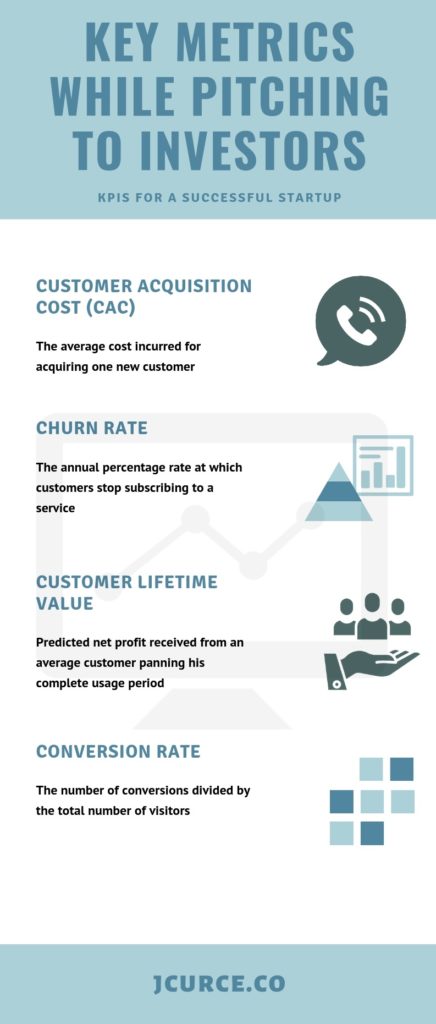5 important startup KPIs and how to pitch them to your investor
Finding the right investment is necessary for the growth of every startup. This involves pitching your venture to investors. Investors are not easily tempted by wild dreams of future growth with no data to hold the claims do not attract them. What does catch their attention is metrics and so it’s of utmost importance to pitch the important startup KPIs to your potential investor.
Several entrepreneurs make rookie mistakes while pitching which immediately destroy their chances of being funded. One such mistake that often crushes investment dreams is pitching the wrong metrics. An example would be the number of outbound emails you sent. Of course a big number looks impressive on paper, however, it proves nothing about the attractiveness of your product and its receptiveness among customers.
Another mistake is forgetting to measure marketing efforts. While organic growth is exciting, attributing all new customers to it is not a good idea. Investors look for a repeatable model where a certain amount of money is spent on marketing to acquire a given number of new leads/ customers

Key metrics to mention while pitching your startup to an investor
Here are some of the most relevant KPIs that must feature in your pitch.
1. Customer Acquisition Cost (CAC)
As the name suggests, CAC measures the cost necessary to acquire new customers. It can be easily calculated by choosing a specific period of time and dividing the total marketing expense during the period by the number of customers acquired during the same timeframe. Tools such as Panalysis help to calculate CAC.
Ideally, the CAC has to be as low as possible. If the CAC is too high, it is necessary to analyze your expenditure and cut costs from areas with poor performance to optimize the CAC before making your pitch. A common example is a website. Many startups spend extravagantly on their website without optimizing it to attract maximum viewers.
2. Retention rate/ Churn rate
While many consider acquiring customers to be the most important part of a startup, retaining them is equally critical to the success of any venture. Retention rate specifies the percentage of customers who have stayed with you over a period of time while the churn rate specifies the percentage of customers who have left over a given period of time. The retention rate needs to be high and the churn as low as possible.
One of the mistakes that entrepreneurs make is to claim they have no churn. While it may sound impressive in your head, in reality, it is better to have analyzed the reasons for churn and have a sorted set of business plans in hand on how to tackle the issues.
3. Customer Lifetime Value (CLV)
In simple terms, CLV is a measure of how much revenue you receive from a customer. It is rather difficult to properly calculate CLV in the initial stages of the business due to lack of sufficient data. This is one of the reasons why it is advised to accumulate around a year worth of statistics before approaching an investor.
In subscription or recurring models it is relatively easier to calculate CLV. If an average customer stays for 12 months, the revenue generated during the 12 months is the CLV. CLV in comparison with CAC provides insights on how the business model needs to be changed. If CAC is greater, the company is not generating profits. If CLV is much higher, then the company can spend more on marketing and aim to capture more customers. CLV often varies among different customer segments and this can help the entrepreneur target the right segment to maximize the profits generated. Investors see a CLV figure as a sign of stability.
4. Conversion Rate
Attracting traffic is often easier than converting them to your customer base. Conversion rate is the rate of the number of visitors (website/app/portal) who become customers.
High conversion rates is a positive sign while low conversion rates highlight a flaw in your product. Communicating to visitors or those who have used the trial version can help you understand the flows and make suitable changes.
5. Margin
Investors fund your business with the aim of making returns. Venture capitalists especially aim to do it in a 3-5 year window. Therefore margin is a very big factor in winning their approval. In general terms, margin is the excess by which revenue generated exceeds the cost of goods sold and operating expenses. Most startups have minimal or no margin. A positive figure can boost your chances of getting funded.
Other KPIs
There are several other metrics which matter depending upon your chosen domain. For a marketplace, it is vital to know about the B2C KPIs around the supply side versus those in the demand side. For e-commerce sites repeat transactions, average order value and cart abandonment are all factors that investors would like to hear about. In case the startup supports a mobile app, the number of downloads, in-app purchases, and subscription model are prerequisite metrics to name a few. Entrepreneurs can seek the guidance of incubators and accelerators for guidance. Besides providing technical expertise, funding, and workspace, incubators such as JCurve also help in refining the pitch and have vast experience in the matter. Happy pitching.
